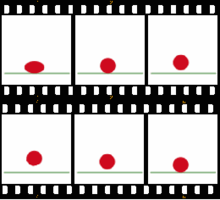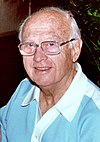
| Main | Categories and topics | Tasks and projects |
Introduction
Animation is a filmmaking technique by which still images are manipulated to create moving images. In traditional animation, images are drawn or painted by hand on transparent celluloid sheets (cels) to be photographed and exhibited on film. Animation has been recognized as an artistic medium, specifically within the entertainment industry. Many animations are computer animations made with computer-generated imagery (CGI). Stop motion animation, in particular claymation, has continued to exist alongside these other forms.
Animation is contrasted with live-action film, although the two do not exist in isolation. Many moviemakers have produced films that are a hybrid of the two. As CGI increasingly approximates photographic imagery, filmmakers can easily composite 3D animations into their film rather than using practical effects for showy visual effects (VFX). (Full article...)
Selected article
"Ricardio the Heart Guy" is the seventh episode of the first season of the American animated television series Adventure Time. The episode was written and storyboarded by Bert Youn and Sean Jimenez, from a story by Merriwether Williams, Tim McKeon, and Adam Muto. It originally aired on Cartoon Network on April 26, 2010. The episode guest stars George Takei (pictured) as the titular character, Ricardio. In this episode, Finn believes that Princess Bubblegum's (voiced by Hynden Walch) new friend, a heart named Ricardio, is evil, and is proven right after learning that Ricardio is the heart of the Ice King (voiced by Tom Kenny). Ricardio reveals that he wants to "make out" with Bubblegum's heart, but he is defeated by Finn and Jake. Ricardio would become a minor recurring villain, reappearing in the fourth season entry "Lady & Peebles". After the episode aired, series composed Casey James Basichis posted a video explaining his inspiration and the method in which he produced the music featured in the episode. Basichis largely scored the episode with opera music, because he felt the genre suited Ricardio. "Ricardio the Heart Guy" was watched by 1.91 million people and received largely positive critical attention, with many reviews praising Takei's voice work.
Selected image
Did you know (auto-generated) -

- ... that the Tuca & Bertie episode "The Jelly Lakes" employs a paper-cutout animation that helps to depict abuse in a way that centers the victim's story?
- ... that the French animated film The Summit of the Gods is based on a Japanese manga series?
- ... that the live-action comedy series Community had a stop motion animated Christmas special?
- ... that the interactive cartoon Cat Burglar takes about 15 minutes to watch, but features 90 minutes of animation?
- ... that the stylized animation of Teenage Mutant Ninja Turtles: Mutant Mayhem was inspired by rough sketches in school notebooks?
- ... that at age 12, Shaylee Mansfield became the first deaf actor to be credited alongside the voice actors for a signed performance in an animated production?
Selected quote
Selected biography
Matthew Abram "Matt" Groening (born February 15, 1954) is an American cartoonist, screenwriter and producer. He is the creator of the comic strip Life in Hell as well as two successful television series, The Simpsons and Futurama. Groening made his first professional cartoon sale of Life in Hell to the avant-garde Wet magazine in 1978. Life in Hell caught the attention of James L. Brooks. In 1985, Brooks contacted Groening with the proposition of working in animation for the Fox variety show The Tracey Ullman Show. The shorts would be spun off into their own series: The Simpsons, which has since aired 765 episodes. In 1997, Groening, along with former Simpsons writer David X. Cohen, developed Futurama, an animated series about life in the year 3000, which premiered in 1999. After four years on the air, the show was canceled by Fox in 2003, but Comedy Central commissioned 16 new episodes from four direct-to-DVD movies in 2008. In 2002, he won the National Cartoonist Society Reuben Award for his work on Life in Hell.
Selected list
Season Three (Book 3: Fire) of Avatar: The Last Airbender, an American animated television series on Nickelodeon, first aired its 21 episodes from September 21, 2007 to July 19, 2008. The season was created by Michael Dante DiMartino (pictured) and Bryan Konietzko and starred Zach Tyler Eisen, Mae Whitman, Jack DeSena, Jessie Flower, Dante Basco, Dee Bradley Baker, Grey DeLisle, and Mark Hamill as character voices. This third and final season focuses on Aang's quest to defeat the tyrannical Fire Lord. In the season's beginning, protagonist Aang and his friends Sokka, Katara, and Toph are traveling through the Fire Nation, conjuring a plan for invading the Fire Nation and looking for a teacher to teach Aang Firebending. Midway through the season, Aang gathers friends he met in previous episodes and leads a failed invasion into the Fire Nation. The final season features twenty-one episodes, one more than the previous two seasons. The season finale consisted of the four episodes airing together as a two-hour television movie. Season Three received a similar positive critical reception to that of the previous seasons. The season, and especially the finale, received much critical acclaim, with praises from sources such as DVD Talk and IGN. Between October 30, 2007 and September 16, 2008, Nickelodeon released four DVD volumes and a "Complete Box Set". Each of the four volume DVDs consisted of one disc and five episodes, with the exception of volume four, which had six episodes, and the boxed set contained all twenty-one episodes on five discs.
More did you know...
- ...that "I Love to Singa," an Al Jolson (pictured) song written by Harold Arlen and E. Y. Harburg, is also the title of a popular 1936 Merrie Melodies cartoon?
- ...that the cast of Home Movies completely improvised the show's pilot episode?
- ...that the Phineas and Ferb episode "Are You My Mummy?" originally aired as part of "Phineas and Ferb-urary," a special event which showed episodes of the series every night in February 2008 on Disney Channel?
Anniversaries for April 27
- Films released
- 1925 – Felix Outwits Cupid (United States)
- 1927 – Sax Appeal (United States)
- 1931 – Disarmament Conference (United States)
- 1934 – Can You Take It? (United States)
- 1935 – My Green Fedora (United States)
- 1940 – The Hardship of Miles Standish (United States)
- 1940 – Porky's Poor Fish (United States)
- 1945 – Shape Ahoy (United States)
- 1951 – Cold War (United States)
- 1956 – Hooked Bear (United States)
- 1963 – Now Hear This (United States)
- 1979 – Pink in the Woods (United States)
- Television series and specials
- 1996 – Dexter's Laboratory, an animated television series debuts on Cartoon Network
- 2012 – Wild Grinders, an animated television series debuts on Nicktoons
- Births
- 1899 – Walter Lantz, American animator (pictured) (d. 1994)
- 1932 – Casey Kasem, American disc jockey, music historian, radio celebrity, and voice actor (d. 2014)
Subportals
Related portals
Wikimedia
The following Wikimedia Foundation sister projects provide more on this subject:
-
 Commons
Commons
Free media repository -
 Wikibooks
Wikibooks
Free textbooks and manuals -
 Wikidata
Wikidata
Free knowledge base -
 Wikinews
Wikinews
Free-content news -
 Wikiquote
Wikiquote
Collection of quotations -
 Wikisource
Wikisource
Free-content library -
 Wikiversity
Wikiversity
Free learning tools -
 Wiktionary
Wiktionary
Dictionary and thesaurus




















